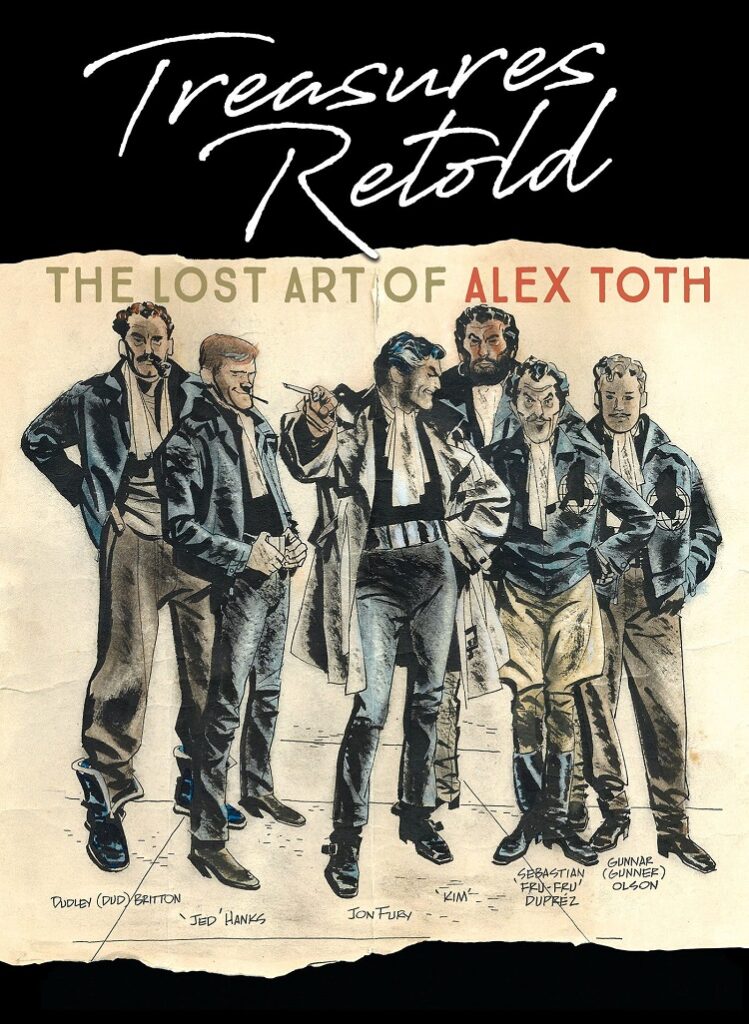
Not too long ago, I had the pleasure of reviewing Alex Toth’s Bravo For Adventure as well as Genius, Animated: The Cartoon Art of Alex Toth, a gigantic tome that served as the third chapter of the Library of American Comics’ overview of the life and career of comic legend Alex Toth, which accompanied 2011’s Genius, Isolated and 2013’s Genius, Illustrated. Together, those three massive (seriously, they’re 9.5” x 13”) volumes provided an astonishing and impossibly in-depth look at one of history’s most accomplished and influential cartoonists. And now, IDW and LOAC once again combine forces like some sort of a publishing Voltron to give us Treasures Retold: The Lost Art of Alex Toth, which serves as a companion piece and epilogue to this amazing biographical trilogy. Collected here for the first time are complete stories from the 1950s and beyond, recently discovered color animation storyboards and presentation drawings, sketches and doodles, industrial comics, and individual pages from obscure comics and magazines. If the Genius series included everything-but-the-kitchen-sink, you could consider this volume the kitchen sink.
Now, there are famous artists, there are great artists, and there are legendary artists, and then there are a select handful of creators who truly deserve the title of “master”. Alex Toth is certainly one of them. His composition and line work are astounding in their directness and simplicity. With just a handful of perfectly placed lines or brushstrokes, Toth could set a mood, depict momentous action, and convey more emotion than just about any other artist I can think of. But beyond his comic work, Toth was probably best known for his forays into animation with Hanna-Barbera during the 1960s and ’70s, most notably Space Ghost, Herculoids, Super Friends, Sealab 2020, and Birdman. And you know you love that stuff.
This 294-page monster showcases that talent in a variety of ways. We get elegant and melodramatic romance comics, action packed westerns, and weird sci-fi and horror. There are supernatural newspaper strips featuring cowboys and monsters. We get several celebrity and movie tie-ins, such as Roy Rogers comics, and a Buster Crabbe comic that bears striking similarities to Flash Gordon whom Crabbe portrayed in a number of movie serials, as well as a few issues of the 77 Sunset Strip and Danny Thomas Show comics. We get historical tales of the FBI and the history of aviation and we get some stories about a family of deep-sea divers who find themselves in all manner of undersea adventure. We even get a story written by Stan Lee. And of course, there are some fantastic storyboards, pitches, and character designs from Toth’s time at Hanna-Barbera.
But perhaps most interesting (to me, anyway) are the various advertisements Toth did, like the Hot Wheels ad campaign that ran in newspapers in 1970 or a comic depicting 350 years of American dairy foods that was given away by the American Dairy Association. There’s an advertisement for the movie adaptation of Jules Verne’s Master of the World starring Vincent Price and another giveaway comic (this time from the Richfield Oil Company) that somehow manages to tie together gold miners and a science lesson to promote Richfield’s new Boron-infused gasoline. It’s not that these comics feature particularly great stories, but they offer an enchanting window into the past as well as showcasing the fact that Toth never skimped on a job or took shortcuts. The work he does explaining the number 5 element on the atomic scale is every bit as skilled and exciting as the story about the crew of the ship that crashes in the Antarctic and finds a world full of dinosaurs. Okay, maybe it’s slightly less exciting, but both stories feature the same level of talent. Toth’s “camera eye” was as proficient as the best Hollywood directors and the man had an innate ability to choose exactly the right angle to properly tell a story, even if it was a story about dairy products.
Also of note are the brief biographical sections in-between each chapter, which delve (but not too deep) into Toth’s personal history and his marriages, which seem to coincide with each major change in his career. Particularly insightful is a self-portrait of Alex pondering his life and career that he had included in a private letter from 1955 depicting the frazzled artist surrounded by his wild and varied thoughts. Even in a “throwaway” sketch, we see the work of a true genius of cartooning.
Treasures Retold: the Lost Art of Alex Toth is the type of book that would be enjoyed by aspiring cartoonists and proficient illustrators – both will find something to learn and enjoy between these covers. It’s a book for comic historians and of course, fans of Alex Toth, as it features a nice sampling of his work throughout the years and shows that the man’s artistic talent aged like a fine wine. As such, this book often feels a little disjointed. This book doesn’t have the focus of the individual volumes of the Genius series, but instead has a little bit of a “leftovers” feel to it. That said, my mom’s famous German potato salad often tastes better on the second or third day, so using the term “leftovers” is hardly an insult in this case. And like any good homecooked meal, Treasures Retold features a smorgasbord of delightful offerings – the kind that really stick to your ribs and leave you satisfied.